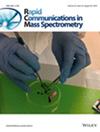Structural characterization of sphingomyelins from tissue using electron-induced dissociation
Abstract
Rationale
Sphingomyelins (SMs) and resulting metabolic products serve important functional and cell signaling roles and can act as potential biomarkers and therapeutic targets in many pathological disorders. SMs each contain a sphingoid base, an amide-linked fatty acyl chain, and a phosphocholine headgroup. Despite these simple building blocks, variations and modifications of both the sphingoid base and the fatty acyl chain result in a diverse array of structurally complicated SM compounds. Conventional tandem mass spectrometry (MS/MS) using the collision-induced dissociation (CID) method only provides limited structural information, necessitating other tools to unravel the structural complexity of these lipids.
Methods
We utilize electron-induced dissociation (EID) and sequential CID/EID approaches to elucidate detailed structural features of SMs. Integrating the CID/EID method into an imaging MS workflow enables accurate identification of SMs directly from kidney tissue.
Results
The application of EID enables identification of SMs at the molecular species level, identifying the sphingosine base and the amide-linked fatty acyl chains. Furthermore, removal of the phosphocholine headgroup via CID followed by sequential EID in an MS3 analysis (CID/EID) enhances the structural information obtained. CID/EID provides diagnostic fragmentation patterns revealing the hydroxylation site and double bond position in both the sphingosine base and amide-linked fatty acyl chains.
Conclusions
Detailed structural information of SMs from synthetic standards and biological tissue samples is obtained using an alternative electron-based dissociation method. Accurate characterization of SMs promises to better inform studies of tissue biochemistry, lipid metabolism, and molecular pathology.

 求助内容:
求助内容: 应助结果提醒方式:
应助结果提醒方式:


